|
A
Park in Ruin
by Bill Young
"Are they shootin' another one
of those things off again? What a waste of money for a box of
rocks. You tell me how we can afford to explore the heavens when
there's still a hell on earth."
Something happened after we made it to
the moon. The Space Age ended. We stopped caring about Space
and a lot of other things as well. Televised launches went the
way of Walter Cronkite. No more ticker-tape parades for astronauts
either. Heroes no longer, we forgot what they were willing to
risk to explore in our name…
… until the cold morning of January
28, 1986.
The Hall of Science
and U.S.Space Park as they appeared in 1967.
SOURCE: Hall of Science
Amateur Radio Club Post Card, posted with permission
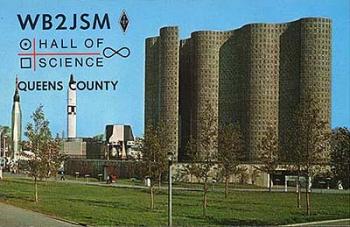 |
With great flourish NASA Director Webb
had dedicated the New York Hall of Science and U.S. Space Park,
congratulating Robert Moses and his associates for their wisdom
in providing generations of New Yorkers with this "symbol
of the impact that science has on our lives." The World's
Fair ended. NASA presented the Space Park as a permanent loan
to Flushing Meadows and entrusted its care to the citizens of
Queens and New York City...
…and then they forgot about it.
|
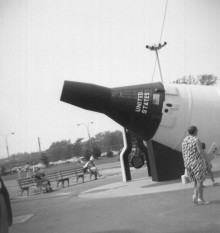
|
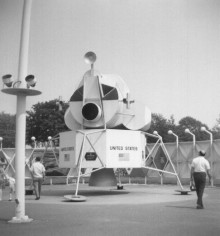 |
|
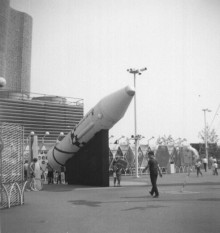
|
These photographs taken by Charles
Aybar on Reopening Day of Flushing Meadows-Corona Park in June,
1967 show a Space Park that looks very much like it did at the
Fair, complete with information panels, lighting and rockets.
© All Photos
Copyright 2002, Dr. Charles Aybar
|
On June 3, 1967, Flushing Meadows-Corona
Park reopened to the public. The Hall of Science and Space Park
were among a handful of treasures that remained from the Fair.
In 1967, the Space Race was nearing its climax. Project Gemini
had been a smashing success and the first of the Apollo launches
would occur in '68. With the moon landing only two years away,
the Space Park was pertinent, educational and still drew crowds…
…but not forever.
The coming decade brought economic disaster
to America's great cities and New York was hit hard. Parks Department
and Museum budgets were slashed. There would be no money for
upkeep or for patrols to protect the legacies of the Fair. The
U.S. Space Park began a rapid, painful decline as it succumbed
to an era of neglect and decay that crept over Flushing Meadows
like a cancer, turning millions of dollars worth of buildings
and statuary and rockets -- gifts from the Fair -- into derelicts.
From the Space Park,
circa early 1980s. The Apollo Command Module and damaged signage
on display.
© Copyright 2002,
Ken Thalheimer
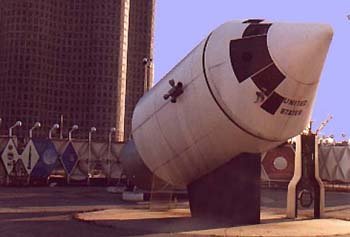 |
Metal corroded. Wood rotted. Fiberglass
faded. Vandals pried and smashed and did their demolition work.
Rockets and satellites were removed from the Space Park and sent
elsewhere. The serpentine walls of rusted, graffiti covered signage
describing the exhibits was removed to keep it from falling on
someone once its supports became too weak to hold it up. This
multi-million dollar gift to America was left to disintegrate
over twenty years, as much a result of apathy as of economic
conditions.
© All Photos Copyright
2002, Rod Smith
|
The U.S. Space Park
as it looked in 1998. The Apollo Command Module is gone from
the site and only a portion of its steel cradle remains. Signage
is derelict. Saturn V Boattail and Rozek's sculpture "Forms
in Space" can be seen in the background.
|
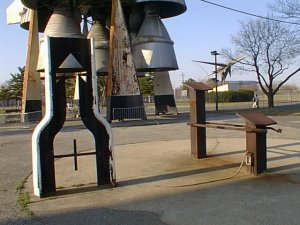 |
|
Looking up at the
5-story high Saturn V Boattail section. Note the disintegrating
wood underside of the mock-up. The Boattail would not be salvageable.
|
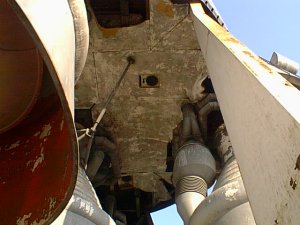 |
|
A close-up
view of the interior of one of the giant F-1 engines of the Saturn
V. Vandals have smashed the exterior revealing a plywood interior
section. The engines of the Boattail would be all that was salvaged
from the mock-up.
|
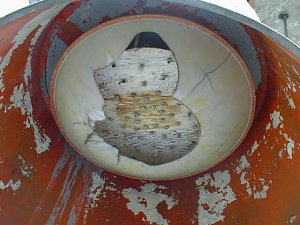 |
|
Base of the
Atlas rocket. A rusted broken arrow is all that remains of the
signage explaining the significance of the rocket. At the top
was perched an actual capsule used in the Mercury Program.
|
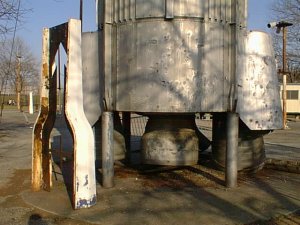 |
|
Closer view
of the Atlas rocket.
|
 |
Nobody gave a damn. Who cared about some
rusty old relics of The Space Age in a far-off corner of the
Park? Visitors came now, not to be impressed or educated, but
to see the broken-down ruins of an outdated display of America's
space program. The Space Race was over and the ratty display
at Flushing Meadows was no longer exciting enough to catch the
imagination except as a prime example of the deplorable upkeep
of Flushing Meadows in general. The public didn't care. The Hall
of Science didn't care. The Parks Department didn't care and
the Borough didn't care.
It closed to the public in 1984.
The U.S. Space park,
June 1, 2001. All that remains is the Atlas rocket and Mercury
Capsule and Titan rocket with Gemini Capsule replica. The remainder
of the park is empty concrete circles and broken asphalt pavement
enclosed in chain-link. Hall of Science guards routed the curious.
© Copyright 2002,
Bill Young
|
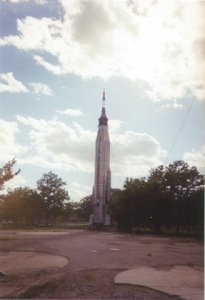
|
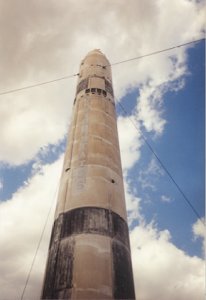
|
Seventeen more years passed by. In the autumn of 2001, workers arrived at the
Hall of Science to begin dismantling the rocket's remains. The
Hall of Science wanted the site occupied by the Park for museum
expansion. Mayor Guiliani and Queens Borough President Claire
Schulman had secured $1 million to restore what everyone was
now calling the "Rocket Park."
It is disgusting to see what little remained
after forty years of neglect. Hardly a "park" anymore,
the site consisted of circles of empty concrete marking the locations
of long-gone exhibits on a crumbling asphalt lot. The Gemini
capsule and Titan rocket, the Mercury capsule and Atlas rocket
and the huge F-1 engines that were a part of the Boattail mockup
of the Saturn V Booster (the Booster itself having deteriorated
beyond salvage) were loaded onto trucks and carted away.
The rockets were taken to Akron, Ohio where
they are being renovated by a firm which has restored rockets
for NASA's Kennedy Space Center and the Smithsonian Institution.
In spring 2004, the rockets will be retuned to the Hall of Science
and will become a featured exhibit of their new "Space City,
" occupying a landscaped area created at the intersection
of the new and old buildings of the museum. It will provide outdoor
program space for summer camp or science fair activities as well.
When opened in Spring
of 2004, the completely renovated Rocket Park will feature a Mercury
capsule with Atlas rocket, and a Gemini capsule with Titan rocket.
Also included will be an interactive Mercury climb-in capsule,
a water rocket launch, and a full size Saturn engine. (Shown in
the background is the Hall's planned two-story addition.
© Copyright 2002,
New York City Hall of Science
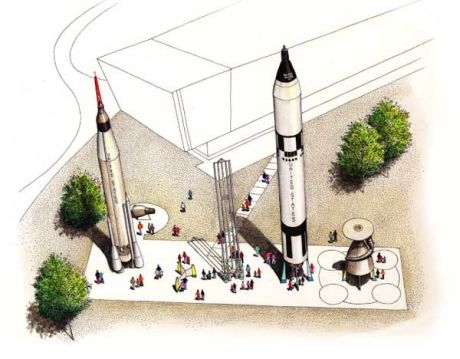 |
A happy ending to the story of the U.S.
Space Park? Hardly.
It is a sad epilogue indeed to report that
it will cost $1 million to restore what was once a multi-million
dollar gift and that so little is left of that gift to restore.
And it is a sad fact that although the Hall of Science, the Parks
Department and the Borough of Queens are willing to take credit
for coming to the rescue at the 11th hour to save the rockets,
no one will be held accountable for the lamentable conditions
that nearly destroyed this wonderful gift to the people of New
York and America from the Fair.
The new Rocket Park will at long last again
be an educational tool and a monument to the time when America
watched breathlessly as hero-explorers blasted off into space
to prepare the way for footsteps on the Moon. May we never again
take for granted these icons of that important era in mankind's
history of exploration that we called The Space Age.
The Hall of
Science Responds
March 8, 2004
... The following are comments that Hall of Science Director Dr.
Alan J. Friedman, Ph.D. provided to nywf64.com in response to our Epilogue.
|
nywf64.com:
The Space Race was over and the ratty display at Flushing
Meadows was no longer exciting enough to catch the imagination
except as a prime example of the deplorable upkeep of Flushing
Meadows in general. The public didn't care. The Hall of Science
didn't care. The Parks Department didn't care and the Borough
didn't care.
Dr. Friedman: I can't speak about
the time before I arrived, but at least from 1984 on this "didn't
care" characterization has been false. Borough President
Claire Shulman and I worked in 1984 and every year afterwards
to plan the preservation and renovation of the Space Park. Several
of the replicas (like the replica lunar lander) were given to
accredited museums (including the Intrepid Air-Sea-Space Museum
and the Cradle of Aviation Museum) who wanted those items, could
afford to transport and care for them indoors, and had collections
in which the replicas made curatorial sense. The Hall of Science
and the City's Department of Design and Construction had surveys
and studies done to make sure the remaining real artifacts, the
Atlas and Titan rockets, were stable and would not suffer additional
damage. Plans for restoration and budgets were drawn up and revised
as needed. Meanwhile we continued to look every single year for
possible funders. It took 15 years, but full funding for the
restoration of those rockets was finally secured, thanks to the
Borough President, Mayor, City Council, and State Legislature.
It was not for a lack of caring or of trying that this didn't
happen sooner. it was for a lack of several million dollars.
nywf64.com:
The Hall of Science wanted the site occupied by the
Park for museum expansion.
Dr. Friedman: Untrue. We had been
working and planning for 15 years to restore the Atlas and Titan
rockets as integral components of the museum's expansion. They
were reinstalled after their renovations only a few feet from
their original locations. The location of the new wing in relation
to the rockets was selected to provide security for the rockets,
within the museum's protected outdoor spaces, to minimize any
opportunity for vandalism and to maximize the opportunity for
museum visitors to view them from both inside and outside the
new wing.
nywf64.com:
It is a sad epilogue indeed to report that it will
cost $1 million to restore what was once a multi-million dollar
gift and that so little is left of that gift to restore. And
it is a sad fact that although the Hall of Science, the Parks
Department and the Borough of Queens are willing to take credit
for coming to the rescue at the 11th hour to save the rockets,
no one will be held accountable for the lamentable conditions
that nearly destroyed this wonderful gift to the people of New
York and America from the Fair.
Dr. Friedman: The orignal Space Park
was wonderful, but it was always intended by its planners to
be temporary. So nobody needs to be "held accountable,"
because the Space Park functioned as it was intended to function,
as a terrific, short-term exhibition. It is incorrect to suggest
that the Space Park was built to be a permanent gift. Because
the Space Park was intended as a temporary exhibition, it was
neither designed nor constructed in a manner that would have
allowed it to survive, even with continuous care, as a permanent
exhibition. The entire interior supports of the Atlas and Titan
were made of PLYWOOD, which would never have been a safe long-term
method of supporting them outdoors. Most of the space park components
were replicas made of similarly inexpensive, limited-lifetime
materials. Short of completely rebuilding the Space Park from
more durable materials (which would have cost far more than the
original Space Park), or moving them to appropriate indoor museums
(which we did), they could never have been sustained as permanent
exhibits.
As far as the renovation, it cost close to $2 million, not $1
million. Nobody claims to have "come to the rescue at the
11th hour" to make that renovation happen. We worked for
15 years to plan and raise money. The rockets were never "nearly
destroyed," and while cosmetically they looked awful, we
kept track during those 15 years to prevent any irreversible
deterioration.
The rockets as restored are much better than they were anytime
before, INCLUDING at the opening of the '64 World's Fair. They
now have more authentic details, and permanent steel interior
skeletons which are designed to withstand hurricane-force winds
and to last indefinitely. They are also displayed without the
ugly guy wires which kept them vertical while on their original
plywood skeletons.
|
VISIT PHILIP BUEHLER'S "MODERN RUINS" WEBSITE TO VIEW
ADDITIONAL PHOTOS OF THE DERELICT U.S. SPACE PARK.
VISIT THE WEBSITE OF THE NEW YORK CITY HALL OF SCIENCE TO VIEW COMPLETE
COVERAGE OF THE REMOVAL OF THE ROCKETS FOR RESTORATION.
|